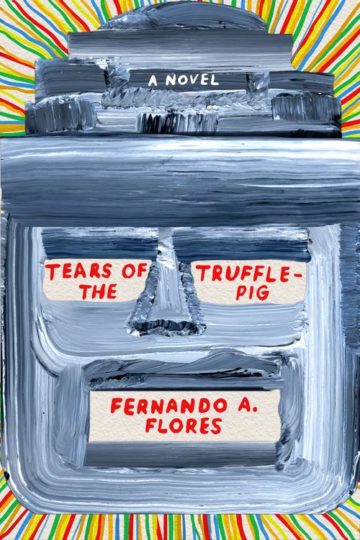
Beasts of the Border
Fernando A. Flores’ debut novel paints a vivid, if cynical, portrait of life on the U.S.-Mexico border.
A version of this story ran in the May / June 2019 issue.
It’s the near future in South Texas, and things haven’t gotten any better. A global food shortage has killed 20 percent of the world’s population and spawned riots in American cities. The legalization of drugs has failed to stop the bloodlust of cartels. The border wall that Donald Trump has dreamed about now exists — there are two walls, in fact, one on each side of the Rio Grande — but it hasn’t stemmed the flow of contraband between the United States and Mexico. This is the vision of Fernando A. Flores, who was born in Reynosa and grew up in the Rio Grande Valley. His debut novel, Tears of the Trufflepig, follows a well-received book of short stories set in the Valley’s punk scene (Death to the Bullshit Artists of South Texas). Trufflepig paints a terrifying portrait of a world where the greed of the 1 percent has turned the planet into a dystopia. It’s a bizarre fever dream of a book made all the more frightening by its eerie plausibility.

by Fernando A. Flores
Farrar, Straus and Giroux
$16; 336 pages
As the novel opens, the reader is introduced to Estaban Bellacosa, a middle-aged man living in the South Texas city of MacArthur. He once owned a successful screen-printing business, but went bankrupt paying medical bills for his late daughter. His wife died shortly thereafter, and the losses torment him.
Bellacosa works as a freelance scout, finding construction equipment for wealthy businessmen and landowners. Some of the town’s rich set, he suspects, are involved in smuggling — not drugs, but “filtered” animals, bioengineered beasts that have been brought back from extinction and are popular pets or food sources for ethically challenged millionaires. Also coveted among the wealthy are the shrunken heads of members of a Native American tribe that calls the Rio Grande Valley home.
While Bellacosa knows he should keep his distance from the traffickers, his curiosity gets the best of him when a young journalist invites him to a clandestine dinner party where rich Texans partake of the meat of filtered animals. Present at the dinner is a real-life trufflepig (the one animal at the meal that’s not intended to be eaten), a mysterious green creature that resembles “a pig with tiny ears” with “a slurping, salivating tongue [hanging] out of its mouth, which was actually a beak.”
Bellacosa soon finds himself in over his head, dodging a local cartel while dealing with the reappearance of his long-estranged brother. He’s unsure whether to trust anyone, including his mysterious journalist friend and his longtime client, a landowner who’s suddenly gone incommunicado. And his quest to find answers leads him to places darker than he’d ever imagined.

It’s not uncommon for authors of dystopian novels to take things a little too far, testing their readers’ willingness to suspend disbelief. But Flores never overplays his hand. Throughout the book, he grounds his vision of the future in enough realism that even the strangest parts of the story come across as plausible. A few years ago, a vision of the border that included walls on either side of the river, extinct animals and openly corrupt cops might have strained the imagination. Unfortunately, it doesn’t anymore.
That’s due in large part to Flores’ observations about the insatiable greed of the ruling class and the cruelty inherent in a system that prizes wealth above all else. Flores looks at human nature with something of a jaundiced eye: “Here, we watch men just naturally become beasts,” Bellacosa’s journalist friend muses at one point. “It’s no miracle of science, either. Maybe a miracle of nature.”
The novel is in many ways a critique of the excesses of capitalism, but it also paints a vivid, if cynical, portrait of life on the U.S.-Mexico border. Trump might have exploited and exacerbated racism and nativism, but he didn’t invent them, and Flores seems to ask readers to consider just how deep-seated American bigotry is: “The border walls, the filtering syndicates, headless bodies of scientists, shrunken Indian heads — he felt these things were always around even before they’d materialized. It was all the continuous overflow of the tension that had been boiling for over a century along the border.”
A few years ago, a vision of the border that included walls on either side of the river, extinct animals and openly corrupt cops might have strained the imagination. Unfortunately, it doesn’t anymore.
And while Flores addresses social, racial and economic justice, Tears of the Trufflepig never descends into polemics. The characters have the complexity of real people, each dealing with their own demons. This is especially true of Bellacosa, whose mourning is realistic and heartbreaking: “My wife took it the hardest,” he recalls of his daughter’s death. “And died of grief. I thought that phrase was an exaggeration before, but I’ve seen it happen in my life.”
Debut novels can be shaky affairs, but Flores writes like a seasoned veteran — his structure and pacing are perfect. And he proves to be an expert at tone. The novel has a hard-boiled noir vibe, but Flores never indulges in the genre’s clichés. Tears of the Trufflepig is a beautifully crafted novel that asks serious questions but doesn’t lose its heart. It also shines a light on horrors that might be closer than we’d like to think: “It wasn’t some monster or cheap science-fiction alien conquest, but people creating all the horror, enslaving one another at all costs in a world where more and more syndicates and absolute power reigned supreme.”


